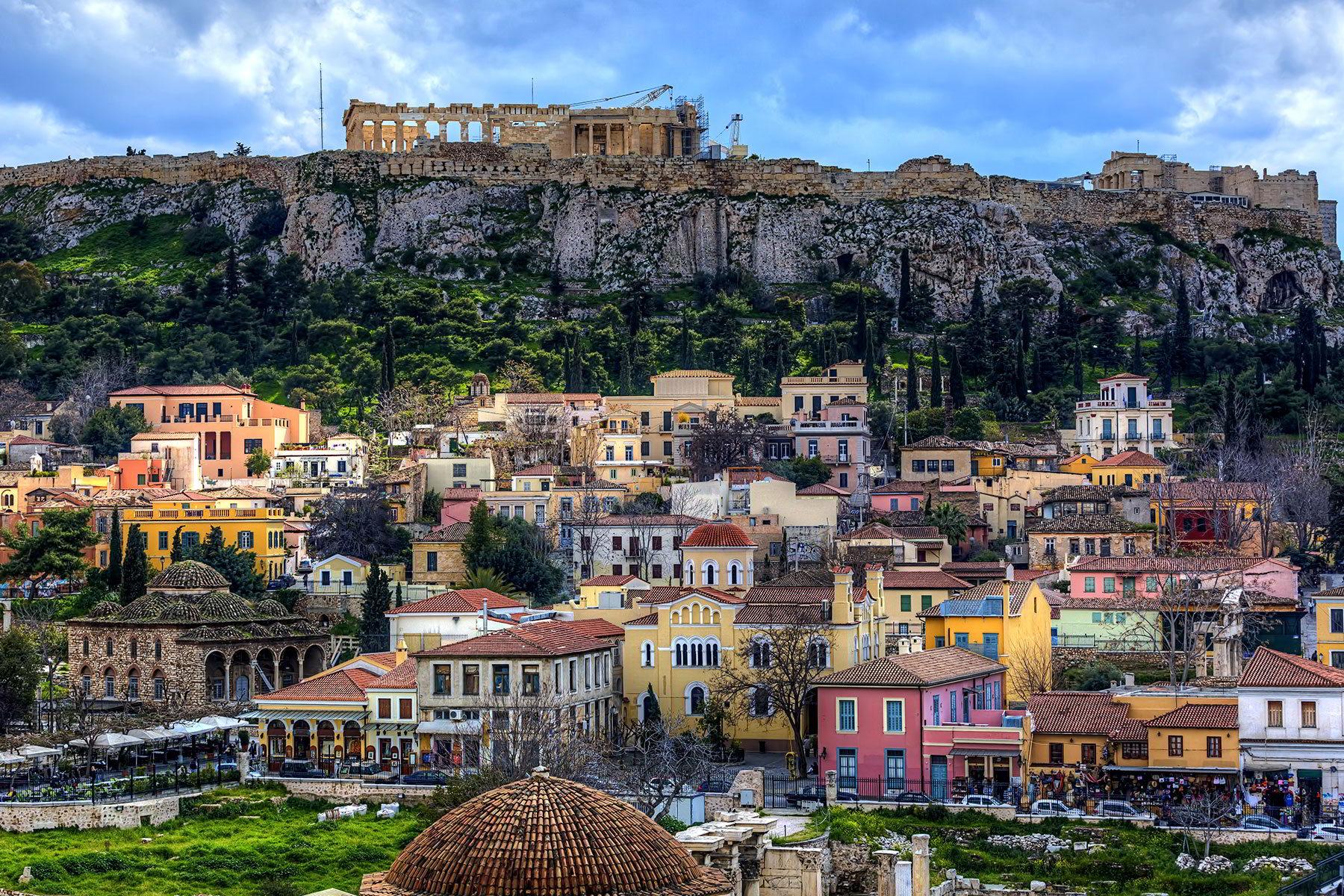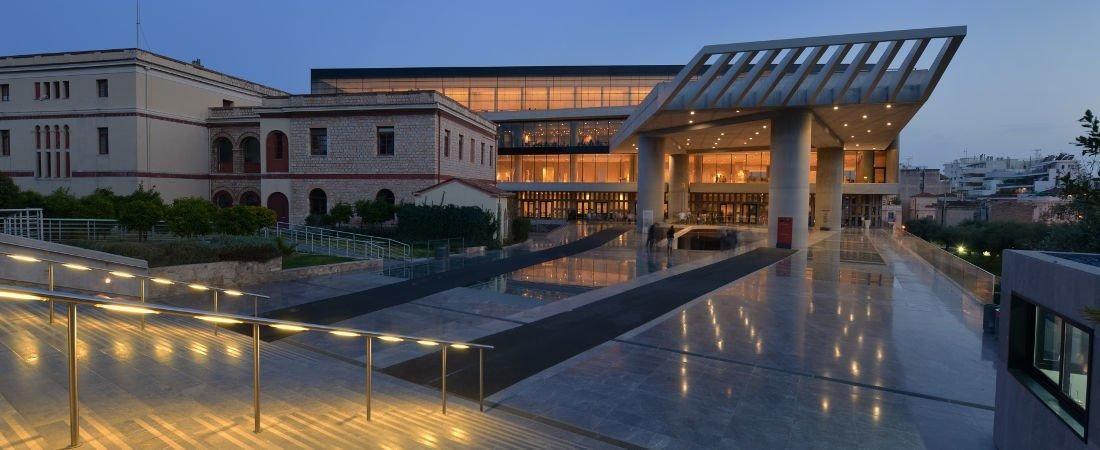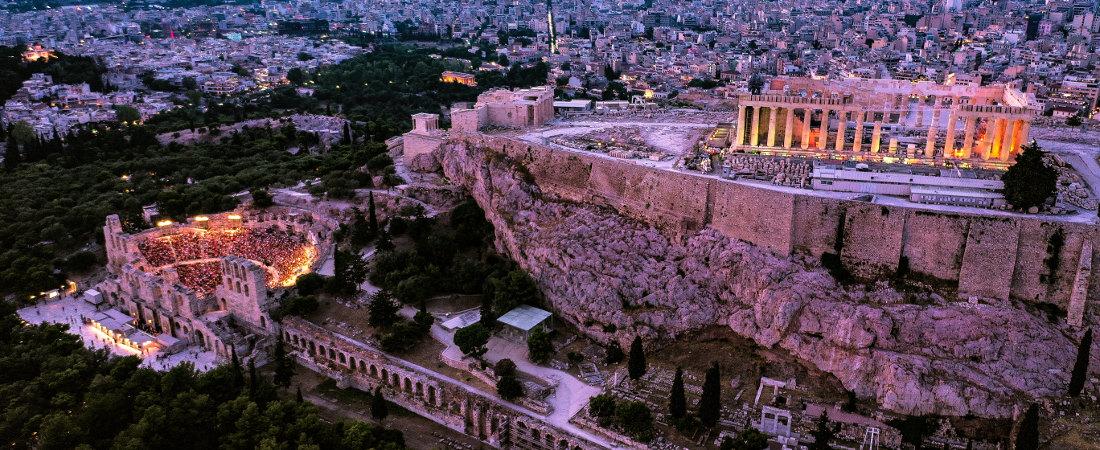Climb on top of The Acropolis of Athens and let the 7000 years of History enchant you.
Admire The Parthenon Temple and feel like one of the Greek Gods surrounded by the Magnificent View of Athens City.
The Acropolis of Athens is one of a handful of places in the world that is so well known, you may be anxious when you finally get here.
Will it be as beautiful as its photographs? Will it be, ever so slightly, a disappointment?
Rest assured: The Acropolis of Athens does not disappoint.
What you want here is time.
Time to watch The Parthenon’s columns appear first beige, then golden, then rose, then stark white in changing light;
Time to stand on The Belvedere and take in the view over Athens City (and listen to the muted conversations floating up from the Plaka area);
Time to think of all those who have been here before you with one of the Athens City Organized Tours.
When you climb The Acropolis of Athens you know that you’re on your way to see Greece’s Most Famous Temple, The Parthenon.
What you may not know is that people lived on The Acropolis of Athens as early as 5,000 B.C.
The Acropolis of Athens sheer sides made it a superb natural defense, just the place to avoid enemies and to be able to see invaders coming across the sea or the plains of Attica.
In classical times, when Athens Citys’ population had grown to around 250,000, people moved down from The Acropolis of Athens, which had become Athens City’s most important religious center.
The Athens City’s civic and business center – the Agora – and its cultural center, with several theaters and concert halls, bracketed The Acropolis of Athens.
When you peer over the sides of The Acropolis of Athens at the houses in the Plaka area, and the remains of the Ancient Agora and the Theater of Dionysos, you’ll see the layout of the Ancient Athens City.
Syntagma square, the heart of today’s Athens City, was well out of the ancient city center.
Even The Acropolis of Athens superb heights couldn’t protect it from the Persian assault of 480 B.C., when invaders burned and destroyed most of its monuments.
Look for the immense column drums built into The Acropolis of Athens walls. They are from the destroyed Parthenon.
When the Athenian Statesman Pericles ordered The Acropolis of Athens rebuilt, he had these drums built into the walls lest Athenians forget what had happened. Pericles’ rebuilding program began about 448 B.C.; The New Parthenon was completed 10 years later, but work on other monuments continued for a century.
You’ll enter The Acropolis of Athens through Beulé Gate, built by the Romans and named for the French archaeologist who discovered it in 1852.
You’ll then pass through The Propylaia, the monumental 5th-century-B.C. entrance.
It’s characteristic of the Roman mania for building that they found it necessary to build an entrance to an entrance!
Just above the Propylaia is the elegant little Temple of Athena Nike (Athena of Victory); this beautifully proportioned Ionic temple was built in 424 B.C. and heavily restored in the 1930s.
To the left of The Parthenon is The Erechtheion, which the Athenians honored as the tomb of Erechtheus, a Legendary King of Athens City.
A hole in the ceiling and floor of the northern porch indicates where God Poseidon’s Trident struck to make a spring gush forth during his contest with Goddess Athena to have the city named in his or her honor.
Athena countered with an olive tree; the olive tree planted beside the Erechtheion reminds visitors of her victory – as, of course, does Athens Citys’ name.
Give yourself time to enjoy the delicate carving on The Erechtheion, and be sure to see The Original Caryatids in The New Acropolis Museum.
The Caryatids presently holding up the porch of The Erechtheion are the casts put there when the originals were moved to prevent further erosion by Athens Citys’ acid nefos (smog).
The Parthenon is dedicated to Athena Parthenos (Athena the Virgin, patron goddess of Athens City) and is, of course, the most important religious shrine here.
Visitors are not allowed inside, both to protect the monument and to allow restoration work to proceed safely.
If you’re disappointed, keep in mind that in antiquity only priests and honored visitors were allowed in to see the monumental – about 11m tall – statue of Athena designed by the great Phidias, who supervised Pericles’ building program.
Nothing of the huge gold-and-ivory statue remains, but there’s a small Roman copy in The New Acropolis Museum – and horrific renditions on souvenirs ranging from T-shirts to ouzo bottles.
Admittedly, the Gold-and-Ivory Statue was not understated;
the 2nd-century-A.D. traveler Pausanias, one of the first guidebook writers, recorded that the statue stood “upright in an ankle-length tunic with a head of Medusa carved in ivory on her breast.
About 2.5m high, with a spear in her hand and a shield at her feet, with a snake beside the shield, possibly representing Erechtheus.”
Look over the edge of The Acropolis of Athens toward The Temple of Hephaistos (now called Theseion) in The Ancient Agora, and then at The Parthenon, and notice how much lighter and more graceful The Parthenon appears.
Scholars tell us that this is because Ictinus, The Parthenon’s architect, was something of a magician of optical illusions.
The columns and stairs – the very floor – of The Parthenon all appear straight, because all are minutely curved.
Each exterior column is slightly thicker in the middle (a device known as entasis), which makes the entire column appear straight.
That’s why The Parthenon, with 17 columns on each side and 8 at each end (creating an exterior colonnade of 46 relatively slender columns), looks so graceful, while The Temple of Hephaistos, with only 6 columns at each end and 13 along each side, seems squat and stolid.
The other reason The Parthenon looks so airy is that it is, quite literally, open to the elements.
In 1687, the Venetians, in an attempt to capture The Acropolis of Athens from the Turks, blew The Parthenon’s entire roof (and much of its interior) to smithereens.
A shell fired from nearby Mouseion Hill struck The Parthenon – where the Turks were storing gunpowder and munitions – and caused appalling damage to the building and its sculptures.
A Britisher, Lord Elgin, carted off most of the remaining sculptures to London – including one Caryatid – in the early 19th century, when Greece was under the Ottoman Empire, to decorate his mansion (!).
When he fell into bankruptcy, he sold what became known as The Elgin Marbles to the British government, which has had them on display in The British Museum since 1816, causing ongoing pain to generations of Greeks, who continue to press for their return.
Things heated up again in the summer of 1988, when English historian William St. Clair’s book Lord Elgin and the Marbles received a fair amount of publicity. According to St. Clair, The British Museum “over-cleaned” the marbles in the 1930s, removing not only the outer patina, but many sculptural details.
The museum countered that the damage wasn’t that bad – and that the marbles would remain in London.
The New Acropolis Museum – with stark-white reproductions of the Missing Marbles in contrast to the originals, honey colored by the Attica sunlight – is the country’s most eloquent and aggressive plea to Britain as of yet.
The Parthenon originally had sculptures on both of its pediments, as well as a frieze running around the entire temple.
The frieze was made of alternating triglyphs (panels with three incised grooves) and metopes (sculptured panels).
The east pediment showed scenes from the birth of Athena, while the west pediment showed Athena and Poseidon’s contest for possession of Athens City.
The long frieze showed the battle of the Athenians against the Amazons, scenes from the Trojan War, and struggles of the Olympian gods against giants and centaurs. The message of most of this sculpture was the triumph of knowledge and civilization over the forces of darkness and barbarians.
An interior frieze showed scenes from The Panathenaic Festival held each August, when citizens paraded through the streets with a new tunic for the Statue of Goddess Athena. Only a few fragments of these sculptures remain in place.
On a smog-free and sunny day, you can see the gold and cream tones of The Parthenon’s handsome Pentelic marble at their most subtle.
It may come as something of a shock to realize that in antiquity, The Parthenon – like most other monuments here – was painted in gay colors that have since faded, revealing the natural marble.
If the day is a clear one, you’ll get a superb view of Athens City from the Belvedere at The Acropolis of Athens east end.
Almost all of what you see comes from Athens Citys’ heyday in the mid-5th century B.C., when Pericles rebuilt what the Persians destroyed.
In the following centuries, every invader who came built monuments, most of which were resolutely destroyed by the next wave of invaders.
If you had been here a century ago, you would have seen the remains of mosques and churches, plus a Frankish bell tower.
The great archaeologist Heinrich Schliemann, discoverer of Troy and excavator of Mycenae, was so offended by the bell tower that he paid to have it torn down.
If you find The Acropolis of Athens too crowded, you can usually get one of the Organized Tours or Private Tours that offered by Hop In Sightseeing or get a peaceful view of its monuments from one of three nearby hills:
- Hill of the Pnyx, where the Athenian Assembly met
- Hill of the Areopagus, where the Athenian Upper House met
- Hill of Filopappos (also known as the Hill of the Muses), named after the 2nd-century-A.D. philhellene Filopappos, whose funeral monument tops the hill.
A visit to the sacred rock in itself however won’t give you the complete picture of the temple’s lavish past.
The New Acropolis Museum displays over 4,000 statues and artifacts that once adorned the temple – most of these treasures are being admired again for the first time in 200 years.
The climb up to the Acropolis of Athens is steep; if you don’t want to walk, an elevator has been installed and the sacred hill is now wheelchair accessible as well.



